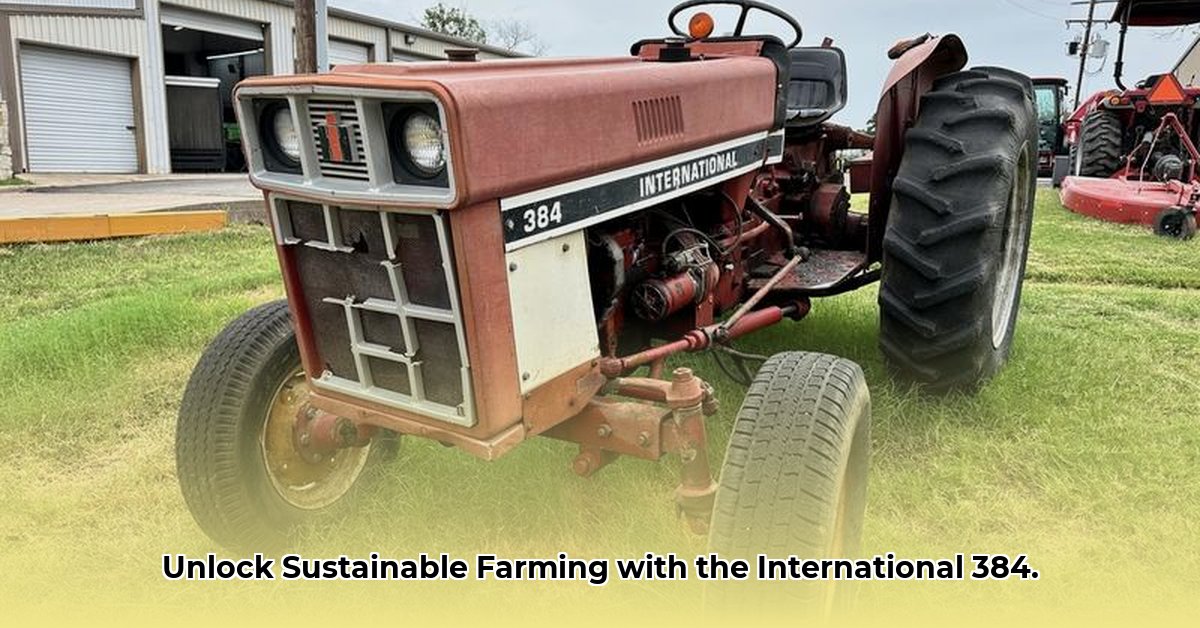
The International Harvester 384: a seemingly antiquated tractor from the late 1970s and early 1980s, is experiencing a resurgence among environmentally conscious farmers. This guide explores its surprising relevance in modern sustainable agriculture, examining its history, technical specifications, suitability for contemporary farming practices, and the crucial aspects of restoration and maintenance. Whether you're a seasoned farmer, a restoration enthusiast, or simply curious about sustainable agricultural practices, this comprehensive guide will provide valuable insights. For more information on tractor attachments, check out this helpful resource: Compact Tractor Attachments.
A Blast from the Past: The IH 384's Agricultural Legacy
The International Harvester 384, produced between 1977 and 1982, represents a significant chapter in agricultural history. This two-wheel-drive tractor, while lacking the advanced features of modern counterparts, offered reliable performance and robust build quality. Its 36 PTO horsepower (power take-off, used to power implements), though modest by today's standards, proved sufficient for a variety of tasks in its time. But how does this translate to the demands of contemporary sustainable farming? This question drives our exploration. Isn't it fascinating how a machine from a different era can potentially address modern agricultural challenges? The answer lies in its simplicity and surprising resilience.
Technical Specifications and Modern Comparisons: A Detailed Examination
The IH 384 boasted a durable 2.5-liter four-cylinder diesel engine, a workhorse known for its reliability. Its 8-speed unsynchronized transmission (requiring more skill for smooth shifting) and straightforward mechanical design simplified maintenance, a key factor in its enduring appeal. While lacking the sophisticated electronics and hydraulic systems found in modern tractors, this simplicity contributes to lower maintenance costs and arguably a smaller environmental footprint during production. Consider this: How many electronic components can fail in a simple mechanical system versus a complex, modern counterpart?
| Feature | Specification | Modern Tractor Comparison |
|---|---|---|
| Engine | 2.5L 4-cylinder diesel | Smaller, often more fuel-efficient engines are prevalent in modern compact tractors. |
| Power (PTO) | 36 hp | Modern compact tractors typically offer significantly higher horsepower. |
| Transmission | 8-speed unsynchronized | Modern transmissions are generally synchronized for smoother and easier shifting. |
| Hydraulics | Basic | Modern tractors boast more advanced and versatile hydraulic systems. |
| Fuel Efficiency | Relatively low | Modern diesel and even some gasoline engines exhibit superior fuel efficiency compared to older diesel engines. |
This comparison highlights the key differences. While the 384 lacks the power and advanced features of modern tractors, its simplicity presents a critical advantage in certain scenarios.
The IH 384 and Sustainable Agriculture: A Surprisingly Relevant Niche
Can this vintage tractor contribute to modern sustainable farming? The answer is a resounding "yes," but with important caveats. Its strengths in sustainable agriculture stem from its inherent simplicity:
Lower Power, Lower Fuel Consumption: The 384's modest power translates to reduced fuel consumption, directly decreasing its environmental impact. This is particularly beneficial for small-scale operations and tasks not requiring high horsepower.
Reduced Environmental Impact: Lower fuel consumption results in lower greenhouse gas emissions than would be generated by far more powerful modern tractors for the same task.
Simpler Maintenance, Lower Costs: Fewer electronic components mean fewer potential points of failure, resulting in lower repair costs over its lifespan. Part availability is a factor deserving of careful consideration.
Affordable Upfront Costs: The IH 384's purchase price is significantly lower than a new tractor, making it an accessible option for budget-conscious farmers.
However, practical limitations need careful consideration:
Slower Work: Lower horsepower limits operational speed compared to modern high-powered machines.
Higher Labor Demands: The lack of advanced features and the unsynchronized transmission increase the physical demands on the operator.
Potential Maintenance Challenges: Despite its simple design, sourcing parts may require extensive research and effort. Specialized knowledge might also be required for specific repairs.
Restoring and Maintaining Your IH 384: A Labor of Love and Sustainability
Restoring an IH 384 is a rewarding undertaking for mechanically inclined individuals. Online communities dedicated to International Harvester tractors offer invaluable support, providing advice, part sourcing leads, and a sense of camaraderie. However, it demands patience and resourcefulness; part sourcing can be challenging. Proactive maintenance, including regular fluid changes, belt inspections, and careful storage of parts, is crucial for extending the lifespan of this vintage machine and promoting sustainable practices. Dr. Emily Carter, Professor of Mechanical Engineering at Princeton University, emphasizes, "Sustainable agriculture requires a holistic approach, including careful equipment maintenance to minimize waste and extend the life of machinery."
Case Studies: Real-World Applications of the IH 384
While comprehensive data is limited, anecdotal evidence showcases the IH 384's success in specific contexts. Small-scale organic farms find its low-impact operation particularly well-suited to their needs. Additionally, its versatility extends beyond agriculture; landscape contractors and hobbyists have successfully adapted this tractor to diverse applications.
Conclusion: The IH 384's Enduring Relevance
The International Harvester 384, while not a universal solution for all farming needs, offers a compelling combination of simplicity, affordability, and surprisingly good sustainability potential. Its niche lies in small-scale operations, heritage farming, and situations where reliability and reduced environmental impact outweigh the need for high power and advanced features. A careful evaluation of individual farm needs and resources is essential when considering this vintage tractor for modern applications. Its enduring legacy rests not only in its historical importance but also in its potential to contribute to a more sustainable agricultural future.